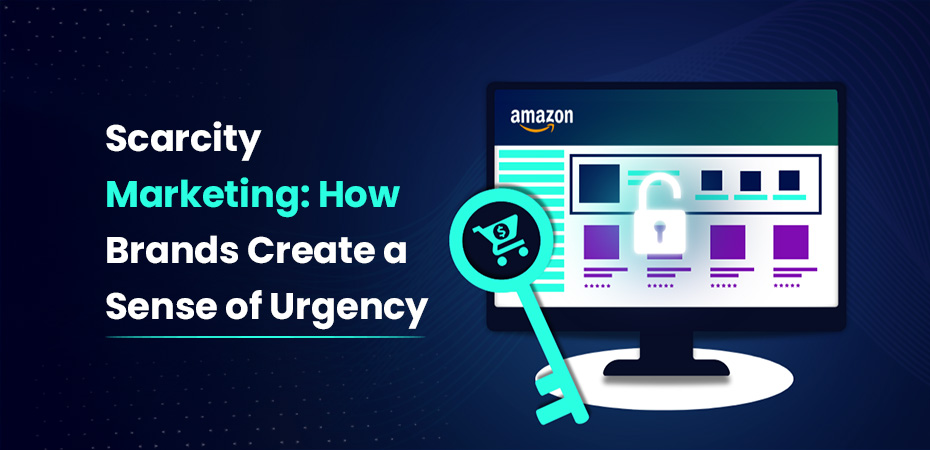Scarcity Marketing: How Brands Create a Sense of Urgency



Have you ever felt that irresistible urge to buy something because it was “almost sold out” or “only available for the next 24 hours”? That’s scarcity marketing in action – a powerful strategy brands use to drive quick purchasing decisions.
Scarcity marketing plays on our natural instincts by making us feel like we need to act quickly because there’s only a limited amount of a product or a short time left to buy it. When we see messages like “Only 2 left in stock” or “Sale ends tonight,” our brains urge us to act fast.
This marketing is done to create desire and it effectively works because it activates several psychological triggers:
- Fear of Missing Out (FOMO)
- Desire for exclusivity
- Competition with other buyers
- Loss aversion
Think about the last time you rushed to buy concert tickets or grabbed a limited-edition product. That intense feeling of racing against time is exactly what brands aim to create. By understanding these psychological triggers, businesses can create compelling campaigns that motivate customers to take immediate action rather than postpone their purchase decisions.
Understanding the Scarcity Principle in Marketing
The principle of Scarcity taps into our basic human instinct – we want what we can’t easily have. Dr. Robert Cialdini, a renowned psychologist, explains this phenomenon in his book “Influence: The Psychology of Persuasion”. He discovered that people assign higher value to items that are difficult to obtain.
Scarcity Examples in Action
Consider special edition sneakers or the latest iPhone. When Apple announces a new phone, people rush to pre-order it. This is not only due to the product’s features, but also because they want to be among the first to own it and fear missing out.
The Role of Psychological Reactance
This behavior links directly to psychological reactance – our natural response when we feel our choices are limited. When we’re told we can’t have something, our desire for it intensifies.
But how does scarcity encourage trade? Remember the toilet paper shortage during the pandemic? The mere suggestion of scarcity triggered panic buying.
How Brands Use Scarcity Effect to Their Advantage
Brands leverage this psychological trigger by creating artificial scarcity of products. Nike releases limited edition shoes in small quantities, while Disney puts films in their “vault,” making them temporarily unavailable. These tactics in marketing work because they activate our deep-seated fear of losing access to something desirable.
Key Elements of Scarcity Marketing
Limited-time offers create a sense of urgency, prompting quick action. Nike’s limited edition sneaker releases demonstrate this effectively—these shoes often sell out within minutes, generating excitement among enthusiasts. These flash sales leverage the fear of missing out (FOMO), driving customers to make immediate purchasing decisions.
1. Real-Time Inventory Updates
Brands like Booking.com masterfully display messages like “Only 2 rooms left!” or “4 other people are looking at this property right now.” This real-time inventory visibility creates immediate pressure on potential customers to make quick decisions.
2. Countdown Timers
Amazon’s Lightning Deals feature a prominent countdown timer alongside limited stock information. This combination has proven highly effective – their Prime Day events generate billions in sales through time-sensitive deals.
3. Limited Edition Products
Beauty brand MAC’s limited edition collections with celebrities consistently drive massive demand. Their collaboration with Lisa from BLACKPINK sold out globally within minutes, demonstrating how exclusivity can create unprecedented demand.
4. Black Friday Strategies
During peak shopping periods, retailers like Best Buy combine multiple scarcity elements:
- Doorbuster deals with strict time limits
- “While supplies last” messaging
- Limited quantity available notifications
- Store-exclusive offers
5. Stock Level Indicators
Fashion retailer ASOS shows low stock warnings (“Only 1 left!”) directly on product pages. This transparency about inventory creates urgency while building trust with customers who appreciate real-time updates.
This marketing through scarcity principles works because it combines psychological triggers with genuine value propositions. When implemented authentically, they create excitement and motivation that drive consumer action while building brand engagement.
The Power of Social Proof, Perceived Value, and Scarcity Marketing Strategies
How Social Proof Enhances Scarcity Marketing
Social proof helps make artificial scarcity marketing more effective. When people see others interested in a product, they want it more. For example, when you see a “12 people are viewing this item” message while shopping, it probably makes you feel like you need to act quickly.
The Impact of Customer Reviews and Testimonials
Customer reviews and testimonials create a powerful narrative around scarce products. A glowing review combined with a “Only 3 left in stock” message creates a compelling reason to act quickly. Brands like Amazon masterfully integrate review counts and ratings alongside their inventory status, making products appear both desirable and limited.
The Role of User-Generated Content
User-generated content adds another layer of authenticity to scarcity marketing. When customers share their excitement about securing a limited-edition item on social media, it triggers emotional responses in others. This fear of missing out drives potential buyers to act swiftly.
Understanding the Psychological Triggers Behind Scarcity
The perceived value of products naturally increases when they’re scarce. Consider these psychological triggers:
- Exclusivity: Limited-edition items feel more special
- Status: Owning rare products creates social distinction
- Competition: The challenge of securing scarce items adds excitement
- Uniqueness: Rare products stand out from mass-produced alternatives
Real-World Example of Scarcity Marketing: Supreme’s Success with Scarcity Marketing
Brands like Supreme use this strategy by selling only a small number of products. Their items sell out in minutes, making people want them even more and creating a sense of urgency to buy quickly.
Effective Scarcity Marketing Tactics
Creating powerful scarcity campaigns requires a deep understanding of your target audience. Different customer segments respond uniquely to urgency triggers, making personalization essential for maximum impact.
Audience Segmentation Strategies
- Demographics-based targeting: Tailoring scarcity messages based on age, location, and income levels
- Behavioral segmentation: Creating urgency based on past purchase patterns and browsing history
- Interest-based targeting: Customizing offers around specific product categories or brand preferences
Let’s consider some real-life scarcity marketing examples. ASOS, a fashion retailer, sends tailored “limited stock” alerts to customers based on their individual style preferences. Sephora, a beauty brand, uses your past purchases to send “last chance” notifications for products you often buy.
Email Marketing Tactics
Email remains a powerful channel for scarcity marketing. Here’s how brands maximize its effectiveness:
- Use countdown timers in emails to highlight time-sensitive offers
- Display real-time inventory updates for watched items
- Send abandoned cart reminders with limited-time recovery discounts
- Create exclusive “subscriber-only” flash sales
The key to successful email scarcity campaigns lies in timing and frequency. Sending too many urgent messages can lead to fatigue, while perfectly timed emails can drive significant sales spikes.
Best Practices for Email Scarcity
- Keep subject lines clear and urgent without being pushy
- Include visual elements showing limited availability
- Personalize send times based on individual engagement patterns
- Test different urgency triggers with small audience segments
- Maintain consistency between email promises and landing page experience
The most successful brands combine these strategies with authentic scarcity signals, creating a sense of exclusivity without compromising trust.
Avoiding Fake Scarcity and Ensuring Authenticity in Marketing
Creating artificial scarcity can backfire spectacularly on brands. When customers discover manipulative tactics, the damage to brand trust can be irreparable. Let’s explore how to maintain authenticity while leveraging scarcity marketing effectively.
Common Misleading Tactics to Avoid:
- Fake countdown timers that reset
- False inventory numbers
- Perpetual “limited time” sales
- Manufactured product shortages
These deceptive practices might drive short-term sales but risk long-term customer relationships. Studies show 86% of consumers value authenticity when deciding which brands to support.
Building Authentic Scarcity:
- Be transparent about actual stock levels
- Set realistic time limits for promotions
- Create genuine limited editions based on production capacity
- Communicate clearly about product availability
Real scarcity happens naturally in business – seasonal products, special collections, or genuine supply constraints. Smart brands leverage these authentic situations rather than manufacturing fake ones.
Best Practices for Authentic Marketing:
- Document the creation process of limited-edition items
- Share behind-the-scenes glimpses of production limitations
- Explain why certain products or deals are truly limited
- Keep customers informed about restocks and availability
Brands like Nike successfully use authentic scarcity through limited sneaker releases, while luxury brands like Hermès maintain exclusivity through genuine production constraints. These examples show how real scarcity can build brand value without compromising trust.
The Benefits of Scarcity Marketing
Scarcity marketing delivers powerful results when executed authentically. Brands implementing this strategy experience a significant boost in sales through several key mechanisms:
1. Accelerated Decision-Making
- Customers make purchases faster when faced with limited supply
- Reduced time spent in the consideration phase
- Lower cart abandonment rates
2. Increased Conversion Rates
- Limited-time offers typically see 2-3x higher conversion rates
- Exclusive deals drive immediate action
- Increased average order value
Scarcity marketing also creates lasting positive impacts on customer loyalty:
- Customers who successfully purchase limited items feel a sense of achievement
- Exclusive access builds stronger emotional connections with brands
- Successful purchases create memorable shopping experiences
The strategy generates valuable social buzz and organic marketing:
- Customers share their “wins” on social media
- Word-of-mouth marketing increases naturally
- Brand perception improves through positive association
Data shows brands using scarcity tactics experience up to 226% higher engagement rates on their marketing campaigns. This heightened engagement translates to:
- Increased email open rates
- Higher click-through rates
- More social media interactions
- Better customer retention rates
When scarcity marketing is paired with personalization, it becomes even more effective. Happy customers share their positive experiences, helping to attract new customers through genuine recommendations and reviews.
Conclusion
Scarcity marketing is a smart way for businesses to drive sales and create strong customer interest. When you understand why this works, you can use it to attract more buyers.
If you want to try scarcity marketing for your business, our team at SEO Expert New York can help. We design campaigns that fit your brand and build customer trust.
As shopping habits and technology change, scarcity marketing also changes. Businesses that use it well can stand out in today’s fast-paced world. Whether you sell online or in a store, these methods can improve your marketing.
Learn how brands use scarcity to their advantage and find out how to create powerful campaigns that bring real results. Let’s explore how you can make the most of this strategy!
Frequently Asked Questions (FAQs)
When used honestly with real limited-time offers or genuine product scarcity, this marketing approach is ethical. The key is maintaining transparency and authenticity in your campaigns.
The ideal duration varies based on your product and audience. Short-term campaigns (24-72 hours) often create the strongest sense of urgency.
Yes! Small businesses can implement scarcity tactics through limited-edition products, seasonal offerings, or exclusive deals for their loyal customers.
Real scarcity involves genuine limitations on product availability or time-sensitive offers. Fake scarcity uses deceptive tactics like false countdown timers or misleading stock levels.